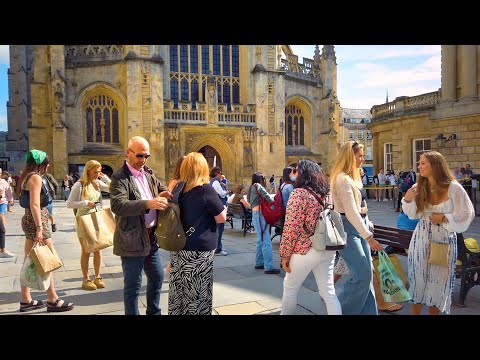Walking in Bath, England - Historic Bath Abbey, Roman Baths & more!

Hello Walkers, we’re in stunning Bath, England on BRUNEL SQUARE outside of Bath Spa Train Station served by GWR and South Western Railway trains It’s 12pm on Thursday 10th September 2020 with the temperature around 16°C/61°F We'll be taking a walk through Bath in Somerset, which is a historic English city known for and named after its Roman-built baths which became a World Heritage site in 1987 The tour includes Thermae Bath Spa, The Cross Bath, The Little Theatre, The Roman Baths, Bath Abbey, Pulteney Bridge, Parade Gardens, Guildhall Market, and The Corridor, famous shopping arcade! with the walk covering 2 miles/3.2 km And don’t forget to look out for the WW logo throughout this walk there are five hidden in total, they could be on a building or object! DORCHESTER STREET Royal Hotel - 3-star hotel Cafe au Lait - coffee house Red telephone box filled with flowers and plants SOUTHGATE STREET The Forum - live music venue, former art deco cinema built in 1934 SouthGate - shopping centre is home to over fifty shops, ten restaurants, 99 homes and an 860-space underground car park LOWER BOROUGH WALLS Cornish Bakehouse - shop selling award winning Cornish pasties in Bath STALL STREET BEAU STREET Bellott’s - former hospital, founded in 1609, rebuilt in 1859 HOT BATH STREET The Hot Bath - with a powerful Tuscan portico Chapel of St Michael Within Thermae Bath Spa - modern glass and stone spa with thermal waters, Roman origins and an open rooftop swimming pool The Little Theatre - cinema, dating from 1935, showing arthouse and mainstream films Hospital of St John the Baptist - historic almshouse constructed in 1716 The Cross Bath - historic pool for bathing it was rebuilt in the style of Robert Adam by Thomas Baldwin around 1789 BATH STREET STALL STREET YORK STREET Archway - decorative arch over York Street, which runs beside the Roman Baths STALL STREET King’s and Queen’s Baths - built over the King's Spring reservoir in the 12th century and the Queen's bath was added to the south of the Spring in the 16th century ABBEY CHURCHYARD Jacks of Bath - souvenir shop The Pump Room - restaurant The Roman Baths, a well-preserved thermae a temple was constructed on the site between 60-70CE in the first few decades of Roman Britain preserved in four main features: the Sacred Spring, the Roman Temple, the Roman Bath House and a museum which holds artefacts from Aquae Sulis Bath Abbey - founded in the 7th century Fancy That of London - souvenir shop ‘The Rebecca Fountain’ - marble fountain, engraved with the words ‘Water Is Best’ Bath Abbey was reorganised in the 10th century and rebuilt in the 12th and 16th centuries with major restoration work carried out by Sir George Gilbert Scott in the 1860s Circular disc of blue limestone by Iain Cotton marks the beginning and end of the Cotswold Way national trail The West door - carved from one piece of wood given to the Abbey in 1617 by Sir Henry Montagu, the Lord Chief Justice, in memory of his brothers Bishop James Montagu and Sir Walter Montagu STALL STREET UNION STREET Entrance to The Corridor shopping arcade, which we’ll visit later on this walk BURTON STREET NEW BOND STREET MILSOM STREET The Ivy Bath Brasserie - British restaurant EDGAR BUILDINGS View north towards the Bartlett Street Quarter with shops, cafes, restaurants, art galleries and antique shops GEORGE STREET BROAD STREET View east along SARACEN STREET towards DoubleTree by Hilton Bath - 4-star hotel The Pig & Fiddle - pub King Edward’s School building, built around 1750 Milsom Place - corridors and courtyards with places to eat and shop Saracens Head - gabled 1713 pub, where Dickens reputedly stayed St Michael’s Church - built between 1835 and 1837 The Podium building housing Waitrose & Partners - supermarket NORTHGATE STREET HIGH STREET Bath & North East Somerset Council Guildhall - 18th-century municipal building the earliest mention of a guildhall here was in 1359, the current Bath stone building was designed by Thomas Baldwin was built between 1775 and 1778 and extended by John McKean Brydon in 1893 BRIDGE STREET Victoria Art Gallery - a public art museum opened in 1900 to commemorate Queen Victoria’s diamond jubilee GRAND PARADE Picturesque horseshoe-shaped weir in the River Avon PULTENEY BRIDGE ARGYLE STREET RIVERSIDE WALK SPRING GARDENS ROAD Ponte Vecchio - Italian restaurant Beazer Garden Maze Back onto RIVERSIDE WALK Pulteney Cruisers - offering scenic cruises up the River Avon to the village of Bathampton on twin decked boats Pulteney Bridge - completed by 1774 connected the city with the land of the Pulteney family, which they wished to develop designed by Robert Adam in a Palladian style it is exceptional in having shops built across its full span on both sides Pulteney Radial Gate - constructed in 1972 as part of the Bath Flood Defence scheme The Recreation Ground - home to Bath Rugby - professional rugby union club NORTH PARADE PIERREPONT STREET The Empire - originally built as a luxury hotel in 1901 it was commissioned by the Admiralty in 1939 and in the mid-1990s converted into exclusive apartments for the over 50s We're now entering the beautiful PARADE GARDENS King Edward VII memorial or Angel of Peace, known as ‘The Peacemaker’ Monk’s Mill - remains of an old water mill owned by the monks of the abbey Colonnades - Tuscan style columns, salvaged at the end of the 19th century from a house in nearby Orange Grove, occupied by Prince of Orange in 1734 Statue of Bladud and his pigs - in 836BC Bladud is said to have founded Bath On Parade Cafe Bandstand - octagonal bandstand with a pyramidal tiled roof Young Mozart statue depicted playing his violin by David Backhouse Sundial globe Xylem sculpture designed by Maureen Hosier RHS Britain in Bloom, City of Bath - award display GRAND PARADE We're now entering Bath Guildhall Market the oldest shopping venue in the city and today houses twenty or so stallholders Central domed roof of this gem of a 19th century building adjoining The Guildhall ‘The Nail’ 18th century pillar (left) on which transactions took place, believed to be the origin of the saying ‘Pay on the Nail’ This brings us back out onto HIGH STREET We're now entering THE CORRIDOR one of Britain's first examples of an indoor, covered shopping arcade which opened in October 1825 UNION PASSAGE CHEAP STREET Our walk is coming to an end So please hit the LIKE button SHARE the video with friends on social media and leave a thoughtful COMMENT down below Don't forget to SUBSCRIBE for more videos (if you haven't already) and tap the bell icon to be notified when I post new videos So until next time, bye for now!
2021-05-06 05:37


